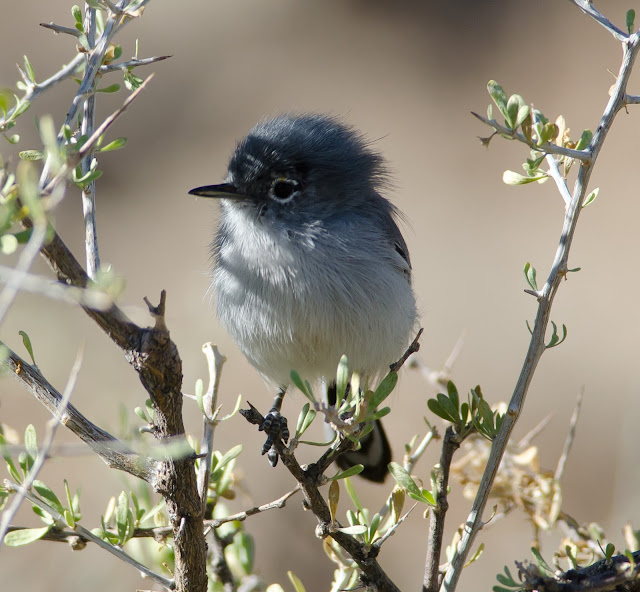On Saturday October 19, I took to Pima Canyon Wash again, but this time with someone new that had never been birding before. Fellow worker, James Tryon joined me in my hike over my familiar trail and showed a keen interest in birds. He has been in this same area before, but like most hikers on these trails, was not aware of the bird life that abounds in this dry desert wash. I did not find anything new or unusual on this trip, but it was very rewarding in the fact that James was quite interested in what I was finding and pointing out to him. These are birds that are very common for me as I have seen them countless times, but it is always an eye-opener when someone new to birding gets their first look at some of these birds and seeing and hearing their reactions. It quickly reminds me of how unique and wonderful all these birds are and why I still enjoy them like I do.
I arrived at the parking lot before the sun came up and was treated to a magnificent full moon setting in the western sky. So of course a photo of the moon was in order.
Since it was dawn and still fairly dark, some of the first birds were not that readily seen with any clarity. But the first bird that made itself presentable and that James got to look at and observe was a Black-throated Sparrow. This is one of those birds that often go unnoticed since they are a sparrow and do not exhibit any bright and bold colors. They are also most generally ground feeders that frequent the areas below small bushes and in the grasses. Their overall brown and gray colors often blend in with their surroundings making them difficult to see. But they are very common and if one has the patience to look for them and listen for them, they can be found. Once you see one up close and see that stunning black throat and those bold black and white markings on the head, then one can truly appreciate the beauty of these 'little brown birds'.
Black-throated Sparrow
A couple of Cactus Wrens were very active in gathering nesting material and building a nest in the forks of a Saguaro Cactus. Not their normal choice for a nest when breeding as they prefer to nest and raise young in various cholla cacti. This nest in a large Saguaro will most likely be used as a roosting nest for the winter months. This one appeared to be gathering as much as it could fit within the confines of its beak.
Cactus Wren
Rock Wrens were calling from all sides of the canyons and were not being very cooperative until on our trip back down the wash to the parking area, when I spotted a movement in the dead brush and rocks. A minute or two later this one popped out into view and allowed great looks for us as well as showing off its behavioral habit of bobbing up and down.
Rock Wren
The Loggerhead Shrike is a bird that I can count on finding at almost every visit to this place. There is a resident pair that has successfully bred for the last 3 years. A very striking bird in its gray, black and white outfit. James mentioned that they remind him of an Air Force Cadet, and I thought that was a pretty good description for these birds.
Loggerhead Shrike
Another common bird to be found in this location is the Black-tailed Gnatcatcher, but it is another one that is often overlooked by hikers, bikers and others walking the trails. Many of the hikers and runners are too busy listening to their electronic devices with their ear buds, so they would not hear this tiny bird. They are actually a bit larger than the various hummingbirds, but as they go about foraging for insects in the low bushes and trees, they are easily missed.
Black-tailed Gnatcatcher
The Curve-billed Thrasher is a bird that is common in a lot of habitats in Arizona. They can be found in urban settings as well as these dry canyon wash areas. Many times I will hear them before actually seeing them with their loud 'wit-a-weet' call that is very familiar. They are another one of those plain brown birds and are much larger than sparrows and gnatcatchers, but that brilliant orange eye and that thick curved bill set them apart and really give them a magical look.
Curve-billed Thrasher
The only mammal that I was able to photograph was a 'wild' canine (alright the adjective 'wild' is really out of line as this one was about as cute and friendly as it could be). Near the apex of our hike we happened upon a very nice man who was getting his very behaved dog, Dominick, to pose for photos on the rocks. What a friendly little guy he was and Neil Liszt was kind enough to allow me to shoot a couple photos of his very photogenic canine companion. So much for the wildlife of Pima Canyon that day!
Dominick
Even though this was a familiar hike for me, seeing all the regular birds that I usually encounter in this spot, it is always gratifying to open up the wonderful aspects of the avian world to new people. Who knows, but we might have another future birder!









No comments:
Post a Comment